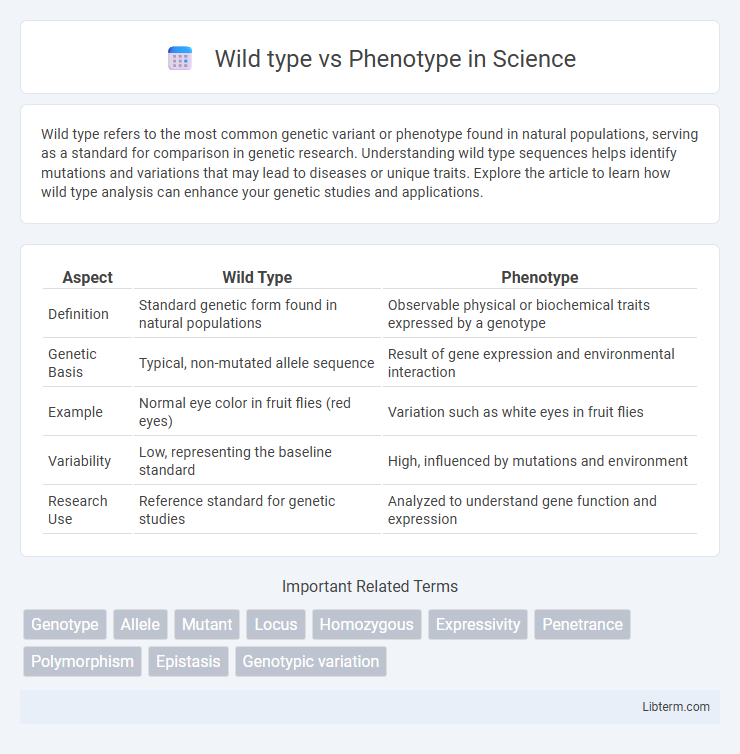Wild type refers to the most common genetic variant or phenotype found in natural populations, serving as a standard for comparison in genetic research. Understanding wild type sequences helps identify mutations and variations that may lead to diseases or unique traits. Explore the article to learn how wild type analysis can enhance your genetic studies and applications.
Table of Comparison
| Aspect | Wild Type | Phenotype |
|---|---|---|
| Definition | Standard genetic form found in natural populations | Observable physical or biochemical traits expressed by a genotype |
| Genetic Basis | Typical, non-mutated allele sequence | Result of gene expression and environmental interaction |
| Example | Normal eye color in fruit flies (red eyes) | Variation such as white eyes in fruit flies |
| Variability | Low, representing the baseline standard | High, influenced by mutations and environment |
| Research Use | Reference standard for genetic studies | Analyzed to understand gene function and expression |
Introduction to Wild Type and Phenotype
Wild type refers to the standard or most common genotype and phenotype observed in natural populations, representing the typical traits passed through generations. Phenotype encompasses the observable physical and biochemical characteristics of an organism, influenced by both genetic makeup and environmental factors. Understanding wild type and phenotype is essential for studying genetic variation, mutation effects, and evolutionary biology.
Defining Wild Type: Genetic Baselines
Wild type represents the standard genetic baseline observed in natural populations, serving as a reference point for identifying genetic variations. This genotype embodies the most prevalent alleles found within a species, providing essential context for distinguishing mutant phenotypes. Understanding wild type is crucial for interpreting genetic experiments and mapping genotype-phenotype relationships in research.
Understanding Phenotype: Observable Traits
Phenotype refers to the observable traits or characteristics of an organism, such as height, eye color, and behavior, which result from the interaction of its genotype with the environment. Wild type represents the standard or most common phenotype found in natural populations, serving as a baseline for comparison with mutant or variant phenotypes. Understanding phenotype is essential for linking genetic information to physical expression and assessing how genetic variations impact an organism's observable attributes.
Genetic Basis of Wild Type and Phenotype
Wild type represents the standard genetic makeup or allele frequency in a natural population, serving as the baseline genotype from which variations arise. Phenotype refers to the observable traits resulting from the interaction between the wild type genotype and environmental factors, reflecting gene expression and regulatory mechanisms. Genetic basis of wild type involves dominant alleles maintaining population stability, while phenotypic variation often emerges from mutations, gene interactions, or epigenetic modifications altering the wild type genetic code.
Wild Type vs Mutant: Key Differences
Wild type refers to the standard or normal genotype and corresponding phenotype commonly found in natural populations, serving as a baseline for genetic studies. Mutants exhibit variations in their DNA sequence that result in altered phenotypes, which can be beneficial, neutral, or detrimental depending on environmental and genetic contexts. Key differences include genetic stability, with wild types maintaining consistent traits across generations, whereas mutants introduce genetic diversity by producing new alleles that may affect organismal function and adaptation.
The Role of Environment in Phenotypic Expression
Environmental factors such as temperature, nutrition, and stress significantly influence phenotypic expression by interacting with an organism's genotype, including its wild type. Even with a stable wild type genetic background, variations in environmental conditions can lead to diverse phenotypic outcomes through gene regulation, epigenetic modifications, and metabolic shifts. This dynamic interaction highlights that phenotype is a product of both inherited genes and the surrounding environment, emphasizing the complexity of trait manifestation in biological systems.
Experimental Methods to Identify Wild Type
Experimental methods to identify wild type often involve genetic sequencing and phenotypic analysis to compare observed traits with documented wild-type characteristics. Techniques such as PCR amplification, gene knockout experiments, and complementation assays help distinguish wild-type alleles from mutant variants by evaluating gene function and expression patterns. Microscopy and biochemical assays provide additional phenotypic data, enabling precise identification of wild-type organisms based on morphological and molecular markers.
Importance of Wild Type in Genetic Research
The wild type serves as the standard genetic backdrop against which phenotypic variations are measured, making it essential for identifying mutations and understanding gene function. In genetic research, maintaining wild type organisms allows scientists to establish baselines for comparative analysis, ensuring accurate interpretation of phenotypic changes. This baseline facilitates the study of gene expression, inheritance patterns, and the molecular mechanisms underlying traits and diseases.
Real-world Examples: Wild Type and Phenotype
The wild type refers to the typical form of a species as it occurs naturally, such as the brown fur coloration in wild-type mice, representing the most common genotype and phenotype in a natural population. Phenotype encompasses all observable traits, like albinism in mice, which results from a genetic mutation altering the wild-type fur color. Real-world examples illustrate how phenotypic variations, driven by genetic differences from the wild type, influence survival and reproductive success in environments.
Implications in Medicine and Biotechnology
Wild type refers to the standard genetic sequence or trait commonly found in natural populations, serving as a baseline for identifying phenotypic variations caused by mutations or environmental influences. Phenotype represents the observable physical or biochemical traits resulting from gene expression, which can indicate disease states or therapeutic responses. Understanding wild type versus phenotype distinctions enables precision medicine approaches, guiding targeted drug development and gene therapies that address specific genetic disorders or optimize biotechnological applications such as genetic engineering and synthetic biology.
Wild type Infographic

 libterm.com
libterm.com